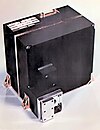ပိုင်အိုနီးယား ၁၀
ဤဆောင်းပါးကို မြန်မာဘာသာသို့ ပြန်ဆိုရန် လိုအပ်နေသေးသည်။
|
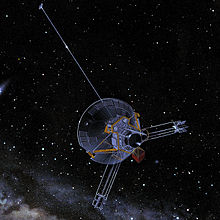 ပိုင်အိုနီးယား ၁၀ | |
| အော်ပရေတာ | ARC / နာဆာ |
|---|---|
| ပင်မ ကန်ထရိုက်တာများ | TRW |
| မက်ရှင် အမျိုးအစား | ဖြတ်သန်းပျံသန်း |
| လွှတ်တင်သည့်ရက် | 1972-03-02 01:49:00 UTC (52 နှစ်၊ 9 လ နှင့် 19 ရက် အကြာက) |
| လွှတ်တင်သည့်ယာဉ် | Atlas-Centaur/TE364-4 |
| လွှတ်တင်သည့် နေရာ | Cape Canaveral Air Force Station Space Launch Complex 36 |
| မစ်ရှင် ကြာမြင့်ချိန် | March 2, 1972 – January 23, 2003 (30 years, 10 months, 22 days) (lost communication) |
| မက်ရှင် စိတ်ဝင်စားဖွယ်များ | Jupiter flyby (completed 1974-01-01) Interstellar mission (completed 1997-03-31) |
| ဖြတ်ပျံ | ဂျူပီတာဂြိုဟ် |
| COSPAR ID | 1972-012A |
| ဝဘ်ပေ့ချ် | Pioneer Project website(archived) NASA Archive page |
| ထုထည် | ၂၅၈ kg (၅၆၉ lb) |
| စွမ်းအင် | 155.0 W (4 Radioisotope thermoelectric generator |
ပိုင်အိုနီးယား ၁၀ အာကာသယာဉ်သည် ၂၅၈ ကီလိုဂရမ်အလေးချိန်ရှိသည့် အာကာသစူးစမ်းလေ့လာရေး စက်ရုပ်ယာဉ်ဖြစ်သည်။ ဂျူပီတာဂြိုဟ်သို့ ပထမဆုံးခရီးနှင်ခဲ့ပြီး နေအဖွဲ့အစည်းမှ လွတ်မြောက်အလျင်ဖြင့်ထွက်ခွာနိုင်ခဲ့သော ပထမဆုံးယာဉ်ဖြစ်သည်။ စီမံကိန်းကို အမေရိကန်အမျိုးသားလေကြောင်းနှင့်အာကာသစီမံမှုအဖွဲ့ (နာဆာ)၏ အမ်းစ်သုတေသနဌာနက ကိုင်တွယ်ခဲ့ပြီး TRW Inc က ယာဉ်ကို ပုံစံထုတ်ခဲ့သည်။ ပိုင်အိုနီးယား ၁၀ ကို အချင်း၂.၇၄ မီတာရှိသည့်စလောင်း၊ ယင်းတွင်ဆက်စပ်တပ်ဆင်ထားသည့် ဆဌဂံပုံကိုယ်ထည်၊ ဖမ်းယူမှုမြင့်မားသည့် အင်တင်နာချောင်းကြီးတစ်ချောင်းတို့ဖြင့် ဖွဲ့စည်းထားသည်။ လိုအပ်သည့်စွမ်းအင်ကို ရေဒီယိုအိုင်ဆိုတုပ် အပူလျှပ်စစ်ဓာတ်အားထုတ်စက်လေးခုပေါင်းမှ စတင်ပစ်လွှတ်ချိန်တွင် ၁၅၅ ဝပ်ရရှိသည်။
ပိုင်အိုနီးယား ၁၀ ကို ၁၉၇၂ခုနှစ် မတ်လ၂ရက်နေ့တွင် ဖလော်ရီဒါရှိ ကိပ်ကာနီဗယ်အာကာသလွှတ်တင်ရေးစခန်းမှလွှတ်တင်ခဲ့သည်။ ဇွန် ၁၅ ရက်နေ့တွင် ဂြိုဟ်သိမ်ဂြိုဟ်မွှားများပတ်လမ်းကိုဖြတ်သွားသော ပထမဆုံးအာကာသယာဉ် ဖြစ်လာသည်။ ၁၉၇၃၊ နိုဝင်ဘာ ၆ ရက်မှစတင်၍ ကီလိုမီတာ၂၅ သန်းအကွာအဝေးမှ ဂျူပီတာဂြိုဟ်၏ဓာတ်ပုံများကို စတင်ပေးပို့ခဲ့သည်။ စုစုပေါင်းဓာတ်ပုံ ၅၀၀ ကျော်ပေးပို့ခဲ့သည်။ ၁၉၇၃၊ ဒီဇင်ဘာတွင် ဂြိုဟ်နှင့်အနီးဆုံး ၁၃၂, ၂၅၂ ကီလိုမီတာအကွာသို့ ရောက်ရှိခဲ့သည်။ ခရီးစဉ်တွင် ယာဉ်ပေါ်တွင် တပ်ဆင်ပေးလိုက်သော ကိရိယာများသည် ဂြိုဟ်သိမ်ဂြိုဟ်မွှားပတ်လမ်းခါးပတ်ကွင်း၊ ဂျူပီတာဂြိုဟ်ပတ်ဝန်းကျင်၊ နေမုန်တိုင်းများ၊ အာကာသရောင်ခြည်များကိုလေ့လာနိုင်ခဲ့သည်။ ယခုအခါနေစကြဝဠာအတွင်းအစွန်ဆုံးရှိ ဟေလီယိုစပီးယားအလွှာ (နေစကြဝဠာ နယ်နိမိတ်အစွန်)သို့ရောက်ရှိနေပြီဖြစ်သည်။ ၂၀၀၃၊ ဇန္နဝါရီ ၂၃ တွင် ကမ္ဘာမှ ကီလိုမီတာ ၁၂ ဘီလျံ (၈၀ AU)အရောက်တွင် ယာဉ်ပေါ်တွင်ဓာတ်အားနည်းပါးလာမှုကြောင့် ဆက်သွယ်မှုပြတ်တောက်ခဲ့သည်။
ယာဉ်ဒီဇိုင်း
[ပြင်ဆင်ရန်]
The Pioneer 10 bus measures ၃၆ စင်တီမီတာ (၁၄ လက်မ) deep and with six ၇၆-စင်တီမီတာ (၃၀-လက်မ) long panels forming the hexagonal structure. The bus houses propellant to control the orientation of the probe and eight of the eleven scientific instruments. The equipment compartment lies within an aluminum honeycomb structure to provide protection from meteoroids. A layer of insulation, consisting of aluminized mylar and kapton blankets, provides passive thermal control. Heat is generated by the dissipation of 70 to 120 watts (W) from the electrical components inside the compartment. The heat range is maintained within the operating limits of the equipment by means of louvers located below the mounting platform.[၁] The spacecraft had a launch mass of ၂၆၀ ကီလိုဂရမ် (၅၇၀ ပေါင်).[၂]:42
At launch, the spacecraft carried ၃၆ ကီလိုဂရမ် (၇၉ ပေါင်) of liquid hydrazine monopropellant in a ၄၂-စင်တီမီတာ (၁၇-လက်မ) diameter spherical tank.[၁] Orientation of the spacecraft was maintained with six 4.5 N,[၃] hydrazine thrusters mounted in three pairs. Pair one maintained a constant spin-rate of 4.8-rpm, pair two controlled the forward thrust, and pair three controlled the attitude. The attitude pair were used in conical scanning maneuvers to track Earth in its orbit.[၄] Orientation information was also provided by a star sensor able to reference Canopus, and two sun sensors.[၅]
သိပ္ပံပစ္စည်းများ
[ပြင်ဆင်ရန်]| Helium Vector Magnetometer (HVM) | |
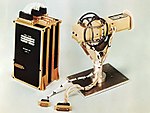
|
This instrument measures the fine structure of the interplanetary magnetic field, maps the Jovian magnetic field, and provides magnetic field measurements to evaluate solar wind interaction with Jupiter. The magnetometer consists of a helium-filled cell mounted on a 6.6–m boom to partly isolate the instrument from the spacecraft's magnetic field.[၆]
|
|
| |
| Quadrispherical Plasma Analyzer | |

|
Peers through a hole in the large dish-shaped antenna to detect particles of the solar wind originating from the Sun.[၇]
|
|
| |
| Charged Particle Instrument (CPI) | |

|
Detects cosmic rays in the Solar System.[၉]
|
|
| |
| Cosmic Ray Telescope (CRT) | |

|
Collects data on the composition of the cosmic ray particles and their energy ranges.[၁၀]
|
|
| |
| Geiger Tube Telescope (GTT) | |
|
Surveys the intensities, energy spectra, and angular distributions of electrons and protons along the spacecraft's path through the radiation belts of Jupiter.[၁၁]
| |
|
| |
| Trapped Radiation Detector (TRD) | |
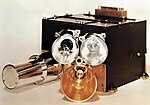
|
Includes an unfocused Cerenkov counter that detects the light emitted in a particular direction as particles pass through it recording electrons of energy, 0.5 to 12 MeV, an electron scatter detector for electrons of energy, 100 to 400 keV, and a minimum ionizing detector consisting of a solid-state diode that measures minimum ionizing particles (<3 MeV) and protons in the range of 50 to 350 MeV.[၁၂]
|
|
| |
| Meteoroid Detectors | |

|
Twelve panels of pressurized cell detectors mounted on the back of the main dish antenna record penetrating impacts of small meteoroids.[၁၃]
|
|
| |
| Asteroid/Meteoroid Detector (AMD) | |
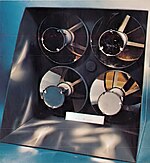
|
Meteoroid-asteroid detector looks into space with four non-imaging telescopes to track particles ranging from close-by bits of dust to distant large asteroids.[၁၄]
|
|
| |
| Ultraviolet Photometer | |

|
Ultraviolet light is sensed to determine the quantities of hydrogen and helium in space and on Jupiter.[၁၅]
|
|
| |
| Imaging Photopolarimeter (IPP) | |
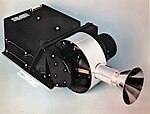
|
The imaging experiment relies upon the spin of the spacecraft to sweep a small telescope across the planet in narrow strips only 0.03 degrees wide, looking at the planet in red and blue light. These strips were then processed to build up a visual image of the planet.[၁၆]
|
|
| |
| Infrared Radiometer | |

|
Provides information on cloud temperature and the output of heat from Jupiter.[၁၇]
|
|
| |
ပိုင်အိုနီးယား သတ္တုပြား
[ပြင်ဆင်ရန်][[File:Pioneer10-plaque tilt.jpg|right|thumb|ပိုင်အိုနီးယား သတ္တုပြား] At the behest of Carl Sagan,[၁၈] Pioneer 10 and Pioneer 11 carry a ၁၅၂ by ၂၂၉ mm (၆.၀ by ၉.၀ in) gold-anodized aluminum plaque in case either spacecraft is ever found by intelligent life-forms from another planetary system. The plaques feature the nude figures of a human male and female along with several symbols that are designed to provide information about the origin of the spacecraft.[၁၉] The plaque is attached to the antenna support struts to provide some shielding from interstellar dust.
မစ်ရှင် ရာဇဝင်
[ပြင်ဆင်ရန်]ပစ်လွှတ်မှုနှင့်လမ်းကြောင်း
[ပြင်ဆင်ရန်]The Pioneer 10 probe was launched on March 3, 1972 at 01:49:00 UTC (March 2 local time) by the National Aeronautics and Space Administration from Space Launch Complex 36A at Cape Canaveral, Florida aboard an Atlas/Centaur launch vehicle. The third stage consisted of a solid fuel TE364-4 developed specifically for the Pioneer missions. This stage provided about 15,000 pounds of thrust and spun up the spacecraft.[၂၀] The spacecraft had an initial spin rate of 30 revolutions per minute. Twenty minutes following the launch, the vehicle's three booms were extended, which slowed the rotation rate to 4.8 per minute. This rate was maintained throughout the voyage. The launch vehicle accelerated the probe for net interval of 17 minutes, reaching a velocity of 51,682 kilometers/hour (32,114 miles/hour).[၂၁]
After the high-gain antenna was contacted, several of the instruments were activated for testing while Pioneer 10 was moving through the Earth's radiation belts. Ninety minutes after launch, the spacecraft reached interplanetary space.[၂၁] Pioneer 10 passed by the Moon in 11 hours[၂၂] and become the fastest man-made object at that time.[၂၃] Two days after launch, the scientific instruments were turned on, beginning with the cosmic ray telescope. After ten days, all of the instruments were active.[၂၂]
During the first seven months of the journey, the spacecraft made three course corrections. The on-board instruments underwent checkouts, with the photometers examining Jupiter and the Zodiacal light, and experiment packages being used to measure cosmic rays, magnetic fields and the solar wind. The only anomaly during this interval was the failure of the star sensor, which instead required the spacecraft to maintain its orientation using the two sun sensors.[၂၁]
While passing through interplanetary medium, Pioneer 10 became the first mission to detect interplanetary atoms of helium. It also observed high-energy ions of aluminum and sodium in the solar wind. On July 15, 1972, Pioneer 10 was the first spacecraft to enter the asteroid belt, located between the orbits of Mars and Jupiter. The project planners expected a safe passage through the belt, and the closest the trajectory would take Pioneer 10 to any of the known asteroids was 8.8 × 106 km (5.5 × 106 mi). One of the nearest approaches was to the asteroid 307 Nike on December 2, 1972.[၂၄]
The on-board experiments demonstrated a deficiency of particles below a micrometer (μm) in the belt, as compared to the vicinity of the Earth. The density of dust particles between 10–100 μm did not vary significantly during the trip from the Earth to the outer edge of the belt. Only for particles with a diameter of 100 μm to 1.0 mm did the density show an increase, by a factor of three-fold in the region of the belt. No fragments larger than a millimeter were observed in the belt, indicating these are likely rare; certainly much less common than anticipated. As the spacecraft did not collide with any particles of substantial size, it passed safely through the belt, emerging on the other side about February 15, 1973.[၂၅][၂၆]
အာကာသနက်
[ပြင်ဆင်ရန်]
Pioneer 10 crossed the orbit of Saturn in 1976 and the orbit of Uranus in 1979.[၂၇] On June 13, 1983, Pioneer 10 crossed the orbit of Neptune, becoming the first man-made object to leave the proximity of the major planets of our solar system. The mission came to an official end on March 31, 1997, when it had reached a distance of 67 AU from the Sun, though the spacecraft was still able to transmit coherent data after this date.[၁]
Analysis of the radio tracking data from the Pioneer 10 and 11 spacecraft at distances between 20–70 AU from the Sun has consistently indicated the presence of a small but anomalous Doppler frequency drift. The drift can be interpreted as due to a constant acceleration of (8.74 ± 1.33) × 10−10 m/s2 directed towards the Sun. Although it is suspected that there is a systematic origin to the effect, none was found. As a result, there is sustained interest in the nature of this so-called "Pioneer anomaly".[၂၈] Extended analysis of mission data by Slava Turyshev and colleagues has determined the source of the anomaly to be asymmetric thermal radiation.[၂၉] In July 2012, the Pioneer anomaly was explained as a thermal recoil force (heat escaping) acting on the face of the Pioneers away from the Sun.[၃၀]
After March 31, 1997, Pioneer 10's weak signal continued to be tracked by the Deep Space Network to aid the training of flight controllers in the process of acquiring deep space radio signals. There was an Advanced Concepts study applying chaos theory to extract coherent data from the fading signal.[၃၁]
The last successful reception of telemetry was received from Pioneer 10 on April 27, 2002; subsequent signals were barely strong enough to detect, and provided no usable data. The final, very weak signal from Pioneer 10 was received on January 23, 2003 when it was 12 billion kilometers (80 AU) from Earth.[၃၂] Further attempts to contact the spacecraft were unsuccessful. The final attempt was made on the evening of March 4, 2006, the last time the antenna would be correctly aligned with Earth. No response was received from Pioneer 10.[၃၃] NASA decided that the RTG units had probably fallen below the power threshold needed to operate the transmitter. Hence, no further attempts at contact were made.[၃၄]
အချိန်ဇယား
[ပြင်ဆင်ရန်]| ပျံသန်းသွားသည့် အချိန်ဇယား | ||||||||||||||||||||||||||||||||||||||||||||||||||||||||||||||||||||
|---|---|---|---|---|---|---|---|---|---|---|---|---|---|---|---|---|---|---|---|---|---|---|---|---|---|---|---|---|---|---|---|---|---|---|---|---|---|---|---|---|---|---|---|---|---|---|---|---|---|---|---|---|---|---|---|---|---|---|---|---|---|---|---|---|---|---|---|---|
| ||||||||||||||||||||||||||||||||||||||||||||||||||||||||||||||||||||
လက်ရှိ အခြေနေ
[ပြင်ဆင်ရန်]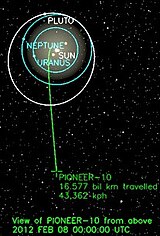
၂ဝ၁၂ ခုနှစ် စက်တင်ဘာလ ၉ ရက်နေ့တွင် ပိုင်အိုနီးယား ၁ဝ သည် ကမ္ဘာမြေမှ ၁ဝ၆.၆၉၆ AUအကွာ၊ နေမှ ၁ဝ၆.၆၇၆AU အကွာသို့ ရောက်ရှိခဲ့ပြီး နေနှင့်နှိုင်းကာ တစ်စက္ကန့်လျင် ၁၂.ဝ၃၇ ကီလိုမီတာ (တစ်နာရီလျင် မိုင်ပေါင်း ၂၆၉၃ဝ)၊ တစ်နှစ်လျင် ၂.၅၃၉ AU နှုန်းဖြင့် ပျံသန်းလျက်ရှိသည်။ ပိုင်အိုနီးယား ၁ဝ သို့နေရောင်ခြည်ရောက်ရှိရန် ၁၄.၇၉ နာရီကြာမြင့်မည်ဖြစ်သည်။ အာကာသယာဉ်မှ နေမင်း၏ တောက်ပနှုန်းသည် -၁၆.၆ ဖြစ်သည်။ ပိုင်အိုနီးယား ၁ဝ သည် ကြယ်စုတန်း တောရပ်ဆီသို့ ဦးတည်နေသည်။
အကယ်၍ အနှောက်အယှက်မရှိပါက ပိုင်အိုနီးယား ၁ဝ နှင့် ညီအစ်မ ပိုင်အိုနီးယား ၁၁ တို့သည် ဗွိုင်ယေဂျာ အာကာသယာဉ်နှင့် ပူးပေါင်းကာ ကြယ်တာရာခရီးအား ဆက်လက်ပြီး ပျံသန်းပါလိမ့်မည်။ ယာဉ်လမ်းကြောင်းသည် Aldebaran ဆိုသည့်ကြယ်ဆီသို့ ဦးတည်နေသည်။ ယင်းကြယ်သည် အလင်းနှစ် ၆၈ နှစ်အကွာတွင် တည်ရှိသည်။ အကယ်၍ ယင်းကြယ်သည် အလျင်သုညရှိမည်ဆိုပါက ယာဉ်အနေဖြင့် ထိုကြယ်ဆီသို့ ရောက်ရှိရန် နှစ်သိန်းပေါင်း ၂ ခုကြာမြင့်ပေလိမ့်မည်။
အခြား ကြည့်ရန်
[ပြင်ဆင်ရန်]- ကာစီနီ-ဟိုင်ဂင်အာကာသယာဉ်
- New Horizons, Jupiter flyby
- ပိုင်အိုးနီးယား ၁၁
- ဗွိုင်ယေဂျာ ၁ & ဗွိုင်ယေဂျာ ၂, Jupiter flybys
ကျမ်းကိုး
[ပြင်ဆင်ရန်]- ↑ ၁.၀ ၁.၁ ၁.၂ Anderson, John D.; et al (April 2002). "Study of the anomalous acceleration of Pioneer 10 and 11". Physical Review D 65 (8). doi:. Bibcode: 2002PhRvD..65h2004A.
- ↑ ၂.၀ ၂.၁ Fimmel၊ R. O. (1974)။ SP-349/396 PIONEER ODYSSEY။ NASA-Ames Research Center။ ISBN SP-349
|isbn=တန်ဖိုး invalid character စစ်ဆေးရန် (အကူအညီ)။ 12 January 2012 တွင် မူရင်း အား မော်ကွန်းတင်ပြီး။ 2011-01-09 တွင် ပြန်စစ်ပြီး။ Unknown parameter|coauthors=ignored (|author=suggested) (အကူအညီ) - ↑ Wade၊ Mark။ "Pioneer 10-11"။ Encyclopedia Astronautica။ 2011-02-08 တွင် ပြန်စစ်ပြီး။
- ↑ Weebau Spaceflight Encyclopedia (9 November 2010)။ 12 January 2012 တွင် ပြန်စစ်ပြီး။
- ↑ Fimmel, van_Allen & Burgess 1980, pp. 46–47.
- ↑ Smith၊ Edward J.။ Magnetic Fields။ NASA / National Space Science Data Center။ 2011-02-19 တွင် ပြန်စစ်ပြီး။
- ↑ Quadrispherical Plasma Analyzer။ NASA / National Space Science Data Center။ 2011-02-19 တွင် ပြန်စစ်ပြီး။
- ↑ ၈.၀၀ ၈.၀၁ ၈.၀၂ ၈.၀၃ ၈.၀၄ ၈.၀၅ ၈.၀၆ ၈.၀၇ ၈.၀၈ ၈.၀၉ Simpson 2001, p. 146.
- ↑ Charged Particle Instrument (CPI)။ NASA / National Space Science Data Center။ 2011-02-19 တွင် ပြန်စစ်ပြီး။
- ↑ Cosmic-Ray Spectra။ NASA / National Space Science Data Center။ 2011-02-19 တွင် ပြန်စစ်ပြီး။
- ↑ Geiger Tube Telescope (GTT)။ NASA / National Space Science Data Center။ 2011-02-19 တွင် ပြန်စစ်ပြီး။
- ↑ Jovian Trapped Radiation။ NASA / National Space Science Data Center။ 2011-02-19 တွင် ပြန်စစ်ပြီး။
- ↑ Meteoroid Detectors။ NASA / National Space Science Data Center။ 2011-02-19 တွင် ပြန်စစ်ပြီး။
- ↑ Asteroid/Meteoroid Astronomy။ NASA / National Space Science Data Center။ 2011-02-19 တွင် ပြန်စစ်ပြီး။
- ↑ Ultraviolet Photometry။ NASA / National Space Science Data Center။ 2011-02-19 တွင် ပြန်စစ်ပြီး။
- ↑ Imaging Photopolarimeter (IPP)။ NASA / National Space Science Data Center။ 2011-02-19 တွင် ပြန်စစ်ပြီး။
- ↑ Infrared Radiometers။ NASA / National Space Science Data Center။ 2011-02-19 တွင် ပြန်စစ်ပြီး။
- ↑ Dyer 1998, p. 302.
- ↑ Carl Sagan, Linda Salzman Sagan and Frank Drake (1972-02-25). "A Message from Earth". Science 175 (4024): 881–884. doi:. PMID 17781060. Bibcode: 1972Sci...175..881S. Paper on the background of the plaque. Pages available online: 1 Archived 28 February 2008 at the Wayback Machine., 2 Archived 28 February 2008 at the Wayback Machine., 3 Archived 28 February 2008 at the Wayback Machine., 4 Archived 28 February 2008 at the Wayback Machine.
- ↑ NASA Glenn Pioneer Launch History။ NASA/Glenn Research Center (March 7, 2003)။ 13 July 2017 တွင် မူရင်းအား မော်ကွန်းတင်ပြီး။ 2011-06-13 တွင် ပြန်စစ်ပြီး။
- ↑ ၂၁.၀ ၂၁.၁ ၂၁.၂ Rogers 1995, p. 23.
- ↑ ၂၂.၀ ၂၂.၁ Fimmel, van_Allen & Burgess 1980, p. 73.
- ↑ Burrows 1990, pp. 17.
- ↑ Fimmel, van_Allen & Burgess 1980, p. 75.
- ↑ Staff (March 1, 1973). "Pioneer 10 beats the asteroid belt". New Scientist 57 (835). New Scientist Publications.[လင့်ခ်သေ]
- ↑ Burgess 1982, p. 32.
- ↑ Fimmel, van_Allen & Burgess 1980, p. 91.
- ↑ Britt၊ Robert Roy (October 18, 2004)။ The Problem with Gravity: New Mission Would Probe Strange Puzzle။ Space.com။ 2011-06-07 တွင် ပြန်စစ်ပြီး။ “The discrepancy caused by the anomaly amounts to about 248,500 miles (400,000 kilometers), or roughly the distance between Earth and the Moon. That's how much farther the probes should have traveled in their 34 years, if our understanding of gravity is correct.”
- ↑ Pioneer Anomaly Solved!။ The Planetary Society။ 22 April 2012 တွင် မူရင်းအား မော်ကွန်းတင်ပြီး။ 2012-04-20 တွင် ပြန်စစ်ပြီး။
- ↑ Support for the thermal origin of the Pioneer anomaly Archived 13 January 2013 at Archive.is, Slava G. Turyshev et al, Physical Review Letters, accepted 11 April 2012, accessed 19 July 2012
- ↑ Phillips၊ Tony။ "Seven billion miles and counting"၊ High Energy Astrophysics Science Archive Research Center, NASA၊ May 3, 2001။ 2011-06-07 တွင် ပြန်စစ်ပြီး။ Archived from the original on 16 November 2012။
- ↑ "This Month in History", Smithsonian magazine, June 2003.
- ↑ Lakdawalla၊ Emily (March 6, 2006)။ The final attempt to contact Pioneer 10။ The Planetary Society။ 16 June 2006 တွင် မူရင်းအား မော်ကွန်းတင်ပြီး။ 2011-06-07 တွင် ပြန်စစ်ပြီး။
- ↑ Angelo 2007, p. 221.
- ↑ Wilford၊ John Noble။ "Pioneer 10 Pushes Beyond Goals, Into the Unknown"၊ The New York Times၊ April 26, 1983။ 13 June 2011 တွင် ပြန်စစ်ပြီး။
- ↑ Pioneer 10။ Solar System Exploration။ NASA။ 5 October 2012 တွင် မူရင်းအား မော်ကွန်းတင်ပြီး။ 13 June 2011 တွင် ပြန်စစ်ပြီး။
- ↑ ၃၇.၀ ၃၇.၁ Update on Pioneer 10။ University of Iowa (February 17, 1998)။ 2011-01-09 တွင် ပြန်စစ်ပြီး။
- ↑ ၃၈.၀ ၃၈.၁ ၃၈.၂ ၃၈.၃ Update on Pioneer 10။ University of Iowa (February 20, 2003)။ 2011-01-09 တွင် ပြန်စစ်ပြီး။
- ↑ Cosmic Distance Scales - The Nearest Star။ NASA။ 2011-06-07 တွင် ပြန်စစ်ပြီး။
- ↑ Pioneer 10 Mission Information။ 21 July 2011 တွင် မူရင်းအား မော်ကွန်းတင်ပြီး။ 2011-01-23 တွင် ပြန်စစ်ပြီး။
- ↑ Pioneer 10 Full Mission Timeline။ Daniel Muller (2010)။ 2011-01-09 တွင် ပြန်စစ်ပြီး။
Bibliography
[ပြင်ဆင်ရန်]- Angelo၊ Joseph A. (2007)။ Robot spacecraft။ Frontiers in space. Facts on File science library။ Infobase Publishing။ ISBN 0-8160-5773-7တမ်းပလိတ်:Inconsistent citationsCS1 maint: ref=harv (link)
- Burgess၊ Eric (1982)။ "Pioneer odysseys"။ By Jupiter: odysseys to a giant။ Columbia University Press။ ISBN 0-231-05176-X။CS1 maint: ref=harv (link)
- Burrows၊ William E. (1990)။ Exploring space: voyages in the solar system and beyond။ Random House။ ISBN 0-394-56983-0။CS1 maint: ref=harv (link)
- Burrows၊ William E. (1999)။ This new ocean: the story of the first space age။ Modern Library။ Random House Digital, Inc.။ ISBN 0-375-75485-7။CS1 maint: ref=harv (link)
- Dyer၊ Davis (1998)။ TRW: pioneering technology and innovation since 1900။ Harvard Business Press။ ISBN 0-87584-606-8။CS1 maint: ref=harv (link)
- Fimmel၊ Richard O.; van Allen၊ James; Burgess၊ Eric (1980)။ Pioneer: first to Jupiter, Saturn, and beyond။ Washington D.C., USA: NASA Scientific and Technical Information Office။CS1 maint: ref=harv (link)
- Launius၊ Roger D. (2004)။ Frontiers of space exploration။ Greenwood Press guides to historic events of the twentieth century (2nd ed.)။ Greenwood Publishing Group။ ISBN 0-313-32524-3။CS1 maint: ref=harv (link)
- Rogers၊ John Hubert (1995)။ The giant planet Jupiter။ Practical astronomy handbook series။ 6။ Cambridge University Press။ ISBN 0-521-41008-8။
- Simpson၊ J. A. (2001)။ "The cosmic radiation"။ in Johan A. M. Bleeker, Johannes Geiss, Martin C. E. Huber (eds.)။ The century of space science။ 1။ Springer။ p. 146။ ISBN 0-7923-7196-8။ Cite uses deprecated parameter
|editors=(အကူအညီ)CS1 maint: ref=harv (link) - Van Allen၊ James A. (2001)။ "Magnetospheric physics"။ in Johannes Alphonsus Marie Bleeker, Arturo Russo (eds.)။ The century of space science။ 1။ Springer။ p. 155။ ISBN 0-7923-7196-8။ Cite uses deprecated parameter
|editors=(အကူအညီ)CS1 maint: ref=harv (link) - Wolverton၊ Mark (2004)။ The depths of space: the story of the Pioneer planetary probes။ National Academies Press။ ISBN 0-309-09050-4။CS1 maint: ref=harv (link)
ပြင်ပ လင့်များ
[ပြင်ဆင်ရန်]- Pioneer Project Archive Page Archived 15 August 2011 at the Wayback Machine.
- Pioneer 10 Profile Archived 1 August 2007 at the Wayback Machine. by NASA's Solar System Exploration
- NSSDC Pioneer 10 page
- A distant Pioneer whispers to Earth - CNN article, December 19, 2002
- 2005 Pioneer Anomaly Conference - Mentions March 4, 2006 Contact Attempt


